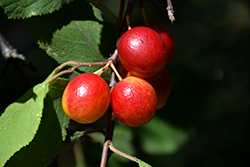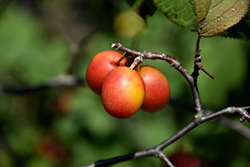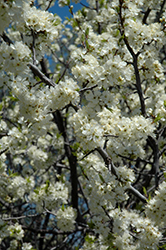It's all about ...
plants

Height: 25 feet
Spread: 15 feet
Sunlight:
![]()
Hardiness Zone: 2a
Description:
This small tree is smothered in showy white flowers in early spring followed by tart red fruit in summer; attractive jet-black bark, compact and upright in habit, very ornamental; needs full sun and well-drained soil, a good pollinator for other plums
Edible Qualities
Canada Plum is a medium-sized tree that is commonly grown for its edible qualities. It produces ruby-red oblong fruit (technically 'drupes') with yellow flesh which are usually ready for picking in late summer. Note that the fruits have hard inedible pits inside which must be removed before eating or processing. The fruits have a sour taste and a juicy texture.
The fruit are most often used in the following ways:
- Cooking
- Baking
- Preserves
Features & Attributes
Canada Plum is clothed in stunning clusters of fragrant white flowers along the branches in early spring before the leaves. It has dark green deciduous foliage. The pointy leaves turn an outstanding yellow in the fall. The fruits are showy ruby-red drupes displayed in late summer. The fruit can be messy if allowed to drop on the lawn or walkways, and may require occasional clean-up. The smooth black bark adds an interesting dimension to the landscape.
This is a deciduous tree with an upright spreading habit of growth. Its average texture blends into the landscape, but can be balanced by one or two finer or coarser trees or shrubs for an effective composition. This plant will require occasional maintenance and upkeep, and is best pruned in late winter once the threat of extreme cold has passed. It is a good choice for attracting birds to your yard. Gardeners should be aware of the following characteristic(s) that may warrant special consideration;
- Disease
Aside from its primary use as an edible, Canada Plum is sutiable for the following landscape applications;
- Accent
- Orchard/Edible Landscaping
Planting & Growing
Canada Plum will grow to be about 25 feet tall at maturity, with a spread of 15 feet. It has a low canopy with a typical clearance of 4 feet from the ground, and is suitable for planting under power lines. It grows at a medium rate, and under ideal conditions can be expected to live for approximately 30 years. While it is considered to be somewhat self-pollinating, it tends to set heavier quantities of fruit with a different variety of the same species growing nearby.
This tree is typically grown in a designated area of the yard because of its mature size and spread. It should only be grown in full sunlight. It does best in average to evenly moist conditions, but will not tolerate standing water. It is not particular as to soil type or pH. It is highly tolerant of urban pollution and will even thrive in inner city environments. This species is native to parts of North America.


